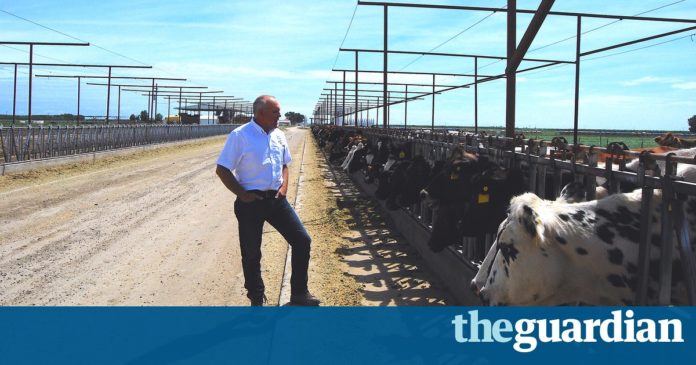For health-conscious, organic-loving shoppers, unpasteurized milk is a developing food fad but food safety officials warn it can be like playing Russian roulette

How do you like your milk: cooked or raw? It may sound an odd question, but its being asked more often at kitchen tables, grocery stores and farmers markets across the US.
The vast majority of milk we drink is pasteurized heat-treated to kill off harmful pathogens. Raw milk, on the other hand, goes straight-out from udder to bottle. Fans call it milk as nature aimed: nutrient-rich and full of probiotics, the very best kind of bacteria. Some devotees go further, calling it a superfood that facilitates digestion, boosts the immune system and treats asthma, eczema and allergies.
For blogger and cookbook writer Jennifer McGruther, trying raw milk several years ago was a natural extension of her interest in traditional diets and locally made food. But in Colorado, where she lived at the time, you couldnt just go to the store and buy it. In reality, due to very concerned about safety, retail sales of raw milk are proscribed in about 20 governments. So she joined something called a herd-share scheme, which lets people buy an interest in a group of dairy cows. As a part-owner, youre entitled to what that cow renders, she explains. Its difficult for the state to say you cant drink the milk from cows you own.
McGruther desired the savour and so did her family. Before long, she tells, her four-year-old son would burst into tears if she committed him regular milk. There is this richness to it, and it tastes different based on the seasons, she tells. There is a uniformity that comes with pasteurization, but food is not uniform.

An increasing number of people concur. For health-conscious, organic-loving shoppers, raw milk is a developing food fad. Who wouldnt seem saddened by the believed to be heat-blasted, barren milk sitting under supermarket strip-lighting when the alternative is painted as a living food, fresh and full of character? Goop recently induced a stir by featuring a naturopathic doctor who recommends an eight-day raw goats milk purify to rid your torso of parasites; some swear by it, others swear it will just stimulate you fart. But when Gwyneth Paltrow jump-start on the bandwagon, you know a food is having a moment.
McGruther agrees that raw milk is a much bigger bargain than it was 10 years ago. She tells many of her 500,000 -plus readers come to her blog, The Nourished Kitchen, specifically to find out more about it. The American government estimates that 3.2% of people now drink it, though advocates I spoke with suggest the above figures is more like 5 %.
But despite the ebullience, its a trend with an unsavory side. Pasteurization is the norm for a reason its extremely effective at killing things such as E coli, salmonella , campylobacter and listeria that they are able hang around in the gut and feces of even healthy cows. Raw milk, on the other hand, relies heavily on the ability of the farmer and the cleanliness of the operation to avoid contamination.
A US food safety official once compared booze raw milk to playing Russian roulette, and the Center for Disease Control and Prevention( CDC) tells raw milk illness have spiked as more people drink it. Between 2009 and 2014, raw milk and raw milk cheese caused the great majority( 96%) of all illness linked to infected dairy products. Considering far fewer people ingest it, that builds unpasteurized dairy 840 times more risky than pasteurized, the CDC tells. The recent deaths among two people who ate raw milk cheese made in New York accentuated the sometimes deadly consequences.
Eight years ago, Michele Jay-Russell, a microbiologist at the University of California at Davis, helped start a website called Real Raw Milk Facts to counter what she describes as a highly sophisticated misinformation campaign lauding both benefits and downplaying the dangers.

She tells several European studies and observations of Amish farm children do indicate those who drink raw milk have less asthma and fewer allergies. But the social sciences is not clear-cut, she adds, and topics remain about whether other factors of farm life proximity to animals, diet, investing time outdoors could have swayed results.
And for young children, whose underdeveloped immune systems stimulate them most vulnerable, the dangers of raw milk make it hard to recommend. For an adult its not really worse than feeing raw oysters or germinates, she explains. But I would say its one of the most risky meat you are able devote small children under five.
Mark McAfee, the founding fathers of Organic Pastures, the nations largest raw milk dairy farm, would differ. Hes been producing and bottling raw milk in Fresno, California, for 17 times. Yes, raw milk can be risky, he tells. But I can make a very good controversy that its safer than pasteurized milk if made expressly for human consumption.
McAfees passion throws him at the vanguard of the pro-raw movement. Hes a gregarious dairyman a fast talker who rattles off potential benefits while steering his truck one-handed as we ride toward the milking barn. He is eager to demonstrate how sanitary the operation is. Milk is pumped straight-out from the cow into super-chilled cisterns. There its held for 24 hours while samples are sent to be tested for E coli and other harmful bacteria.
Business is booming, he tells, with annual marketings at $12 m and developing and some 80,000 people drinking his milk in California, including celebrity fan Martin Sheen.

At the farm I get chatting with Maggie and Dana Troutman, raw milk drinkers from San Diego. Maggie tells she was raised on the stuff and allegations her family had not yet been history of illnes as a result. When Im traveling and I cant get my raw milk, I notice a difference in two days, she tells. I dont seem strong. Its like my cells are starving.
But Organic Pastures has had its developing pains. Their milk has been linked to multiple outbreaks, including an E coli outbreak in 2006 that left several children hospitalized. One of those children was seven-year-old Chris Martin, who developed acute kidney failing that nearly killed him.
Chriss mother, Mary McGonigle-Martin, told me she didnt grow up feeing healthy but give attention to raw milk because she had heard it was more nutritious. I thought it was supposed to be good for you. I was lulled into a false sense of security.
McGonigle-Martins story highlightings just how personal, and at times contentious, the debate has become. The raw milk movement is, after all, fighting against a significant advancement in food safety thats credited with saving millions of lives. In the early 20 th century before pasteurization became widespread in the US one in four foodborne illness were caused by milk. Today its less than 1 %.
But for those who love it, drinking raw milk isnt just about the savour or supposed health-giving effects its about a return to a pre-industrialized past, a rejection of mass production, a middle thumb to the government for curtailing food choices.( Its legal to buy plenty of other things that kill you, after all, from cigarettes to soda .)
When I speak to my students now, “they il be” far more concerned about things like antibiotics, GMOs, pesticides and hormones in their food, tells Jay-Russell, the microbiologist. They think theyre avoiding the frights of industrialized, processed food.
But, she adds, people have forgotten that sometimes there was a reason for those processes in the first place.
Read more here: http :// www.theguardian.com/ us







